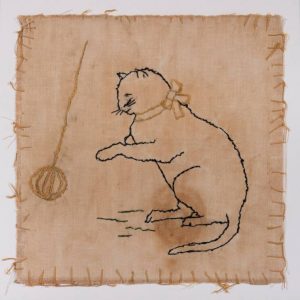
An embroidery made by a young T. S. Eliot hinted at things to come. The embroidery, made in 1894, shows a ribbon-collared cat ready to pounce on a ball of wool. It’s believed Eliot first put pen to paper with his cats in a 1931 letter to his young godson, Tom Faber, who had written to Eliot about his cat. ‘I am glad you have a Cat’ Eliot wrote, ‘but I do not believe it is So remarkable a cat as My cat. My Cat is a Lilliecat Hubvsouly… ITS NAME IS JELLYLORUM’. There followed further letters to Eliot’s godson introducing the Pollicle Dogs and Jellicle Cats, and the Practical Cat who can be seen trying out country life pursuits with Eliot in the drawings illustrating the letter. Between 1936 and 1938, poems were written and sent to friends and their children for comment, before their eventual inclusion in Old Possum’s Book of Practical Cats.
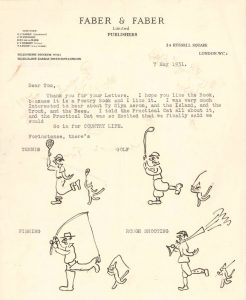
In their Spring 1936 catalogue, Faber & Faber announced Mr Eliot’s Book of Pollicle Dogs and Jellicle Cats as Recited to Him by the Man in White Spats. It would take over three years for the book to materialise, with the dog poems discarded in favour of a book solely about cats. In March 1936, Eliot was unsure of how successful he would be in writing children’s verse. He sent Pollicle Dogs and Jellicle Cats to Geoffrey Faber, together with drawings and a covering memo:
‘I am more and more doubtful of my ability to write a successful book of this kind, and I had rather find out early that I can’t do it, than waste a lot of time for nothing. And this sort of thing is flat if it is flat, than serious verse. Nobody wants to make a fool of himself when he might be better employed.’
Pollicle Dogs and Jellicle Cats didn’t make the final book (it can be found in Volume 1 of The Complete Poems of T. S. Eliot) but Eliot followed it up with further poems written and sent on periodically to the Tandy and Faber families, Bonamy Dobree, and John Hayward. In December 1937 five of the Practical Cats were broadcast by the BBC on Christmas Day, with the poems read by broadcaster and scientist Geoffrey Tandy. The broadcast proved a great success with repeat broadcasts and two new sets of readings the following year, establishing an audience eager to see the poems in print.
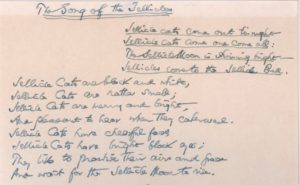
Eliot had hoped that Ralph Hodgson (‘The Man in White Spats’) would illustrate the first edition of the book, but Hodgson was unavailable and so Eliot illustrated the front cover and dust jacket himself. This first edition, however, lacked illustrations inside the book and so Nicholas Bentley was commissioned to illustrate a new edition in 1940, and these drawings are the Practical Cats most of us know today. When Bentley submitted his initial drawings they were unanimously approved by the Faber Book Committee, with one suggestion: that the cat “ought possibly to look less worried, as his face at present suggests anxiety more than contemplation”.
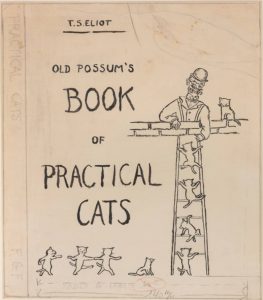
Eliot was worried about the poems’ reception, wanting them to be a success in their own right, and wrote to Geoffrey Faber in July 1939, ‘I was so anxious that the Cats should flourish, if at all, on their own merits, and not as a TSE curio, that I would have asked that it be published anonymously had I thought that fair to the publishers; it is intended for a NEW public, but I am afraid cannot dispense with the old one.’ Eliot couldn’t have foreseen the immense success of Cats the musical, but he did see Practical Cats as crucial to his own financial prospects. A month before publication, in September 1939, he confided to John Hayward, ‘My financial future… seems to depend on CATS’.
Old Possum’s Book of Practical Cats was published on 5th October 1939 in an edition of 3005 copies at 3/6d and proved early on to be popular with fans old and new. A month after publication, Eliot reported to John Hayward that Cats continued to give ‘”general satisfaction”, and have been selling upwards of 200 a week’, in contrast to The Idea of a Christian Society (published on 26 October) which was ‘not moving so rapidly’. The poems continue to be hugely popular with readers today.
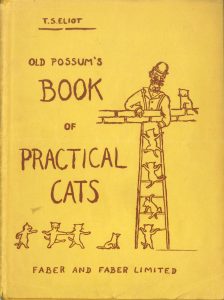
Eliot received numerous fan letters regarding Practical Cats – people of all ages felt moved to share details of their own cats, their names and quirks. One gentleman sent a large watercolour illustration of himself and his cats, together with a poem about them. Dorothy Pound responded with a letter devoted to cat chat, describing how Ezra Pound’s black cat ‘Swartz’ wouldn’t walk across the snow-covered rooftops in Rapallo, unlike the gray-white cats there. Twenty years after the book’s first publication, Mr and Mrs Eliot were offered a blue Burmese kitten by a lady who had given each member of the litter ‘Practical’ prefixes to their names, while another aquaintance described the poems as medicine for his children.
Eliot received many poetical responses to Practical Cats, including one from a Mrs Skinker who wrote him a letter in rhyme. Eliot, naturally, replied with his own rhyming letter:
‘Thank you for your letter. I am grieved to find
That in respect of felines you are so confused in mind.
You would be qualified to criticise me if you had
Perceived the truth that no one Cat is wholly good or bad…’
In 1942, John Wilson at John & Edward Bumpus Bookshop sent Eliot a bomb-damaged copy of the book which had narrowly missed being completely flattened by a five hundred pound bomb which fell through the shop during the Blitz. Eliot sent the book on to his brother in America who he thought would “be suitably impressed and exhibit the copy.”
Andrew Lloyd Webber was not the first composer to consider setting the Cats poems to music. The first appears to have been Colin Taylor, who in 1945 sought permission, via publishers Edward Arnold & Co, to set ‘Macavity: the Mystery Cat’ to music, and in 1954 six settings from Practical Cats were performed at the Edinburgh Festival.
In an audio recording made by the British Council in the spring of 1957, Eliot was asked if he would record his Practical Cats with them, as he had done ten years previously with Four Quartets. It was suggested that Cats might be easier to read than the Quartets, but Eliot disagreed, replying
‘I am not so sure of that, no, no you’ve got to er, you’ve got to put a lot of energy into some of those Cats’.
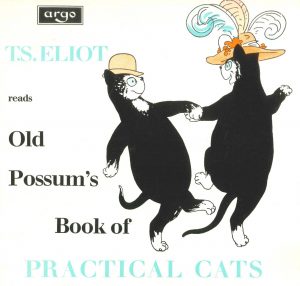
Read about the first broadcast of Practical Cats here and Valerie Eliot’s Apropos of Practical Cats here.


